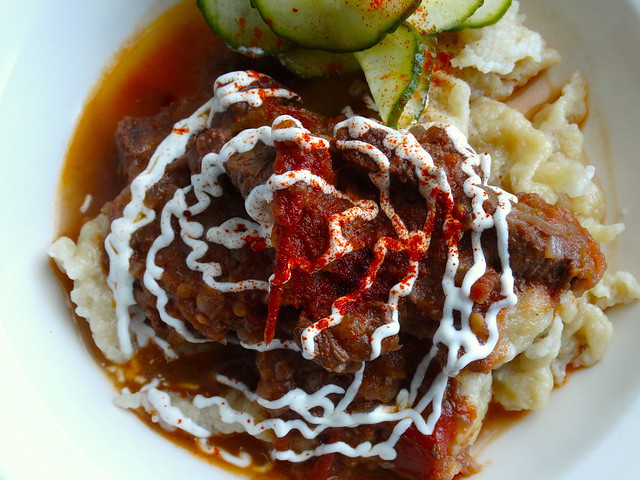Discover the Nutritional Benefits of Braising and Stewing
Red Wine Beef Stew with Spätzle by Zannnie (Hungarian Recipe)
VÖRÖSBOROS MARHAPÖRKÖLT NOKEDLIVEL -Hungarian Traditional Dish, photo: zannnie -
Ingredients: Beef, onion, tomatoes, carrot, red wine, paprika power, seasoning salt.
For the Spätzle: Egg, flour, water, salt. 10.7.2016 @ Ulemiste, Tallinn, Estonia.
Ingredients:
- 2 Cucumbers, medium
- 2 cloves Garlic
Spices
- 1/2 tsp Paprika
- 1/4 tsp Pepper
- 2 tsp Salt
- 1 tsp Sugar
Oils & Vinegars
- 2 tbsp Vegetable or salad oil
- 1/2 cup White vinegar
Dairy
- 2 tbsp Sour cream
Liquids
- 1 cup Water
Beef Stew Ingredients:
1 kg shank
4 onions
6-8 cloves of garlic
500ml red wine
2 tomatoes
1 green pepper
1 beef stew cube
50g smoked bacon (szalonna)
2-3 tbsp ground paprika powder
2 tsp salt
1 tsp pepper
1 tsp cumin powder
3-5 bay leaves
Preparation:
Add the bacon into the pan, fry chopped onion, caramelize the onions.
Add meat when onion turns pale.
Add the salt, pepper, paprika, tomatoes, green pepper, chopped garlic and beef stew cube.
Add Red Wine and let it simmer on low heat until meat is tender.
Add the remaining paprika powder and sour cream as topping.
Serve with nokedli (dumplings) or spatzel or potatoes. It is delicious to eat with bread (baguette) too.
- For my vegetarian or vegan friends, you may want to try out the following stews:
- Ratatouille: A French vegetable stew typically made with eggplant, zucchini, bell peppers, onions, garlic, and tomatoes, flavoured with herbs such as thyme and basil.
- Lentil stew: A hearty stew made with lentils as the main ingredient, typically flavoured with vegetables, herbs, and spices. It can be made with various types of lentils and can be vegan or include meat.
- Chickpea stew: A stew made with chickpeas as the main ingredient, often combined with vegetables and spices such as cumin, paprika, and coriander. It can be served as a side dish or a main course.
- Gumbo: A southern US stew that typically contains a variety of vegetables, meat or seafood, and a thickener such as roux or okra. It is usually served over rice.
- Minestrone soup: An Italian vegetable soup made with a variety of vegetables such as carrots, celery, beans, and tomatoes, often with pasta or rice added for extra substance.
- Vegetable curry: A flavourful dish originating in South Asia, made with a blend of spices such as turmeric, cumin, and coriander, and various vegetables such as potatoes, cauliflower, and peas.
- Vegetable chili: A hearty dish made with a tomato-based sauce, chili peppers, and a variety of vegetables such as beans, onions, and bell peppers. It can be served with rice, bread, or tortilla chips.
- Vegetable tagine: A North African stew made with a variety of vegetables, often including sweet potatoes and chickpeas, flavoured with spices such as cinnamon, cumin, and ginger.
- Creamy mushroom stew: A rich and creamy stew made with mushrooms as the main ingredient, often combined with onions, garlic, and herbs such as thyme and rosemary.
- Corn chowder: A creamy soup made with sweetcorn as the main ingredient, often combined with potatoes, onions, and other vegetables, and flavoured with herbs such as thyme and bay leaves. It can be served hot or cold.
Braises and stews are comforting, hearty dishes that are perfect for cold winter nights or lazy weekends. They are also great for meal prep, as they can be made in large batches and reheated easily. In this post, we'll explore the basics of braising and stewing, as well as some tips and tricks for making delicious, flavourful dishes.
Braising vs. Stewing
First, it's important to understand the difference between braising and stewing. While both methods involve cooking meat and vegetables slowly in a flavourful liquid, there are some key differences.
Braising typically involves searing meat in a hot pan to develop a crust, and then cooking it slowly in a covered pot with a small amount of liquid. This method works well for tougher cuts of meat, as the long, slow cooking process breaks down the connective tissue and makes the meat tender and flavourful.
Stewing, on the other hand, involves cooking meat and vegetables in a liquid for an extended period of time, until everything is soft and tender. Stews can be made with a variety of ingredients, and are often served with bread or rice to soak up the flavourful broth.
Ingredients
The key to a delicious braise or stew is using fresh, high-quality ingredients. For braising, choose tougher cuts of meat that will benefit from the long cooking time, such as beef brisket, pork shoulder, or lamb shanks. For stews, you can use a wider variety of meats, including chicken, fish, or even vegetarian or vegan alternatives like mushrooms or lentils.
In addition to meat, you'll also need vegetables, herbs, and spices to add flavour and depth to your dish. Popular choices include onions, garlic, carrots, celery, potatoes, and mushrooms, as well as herbs like thyme, rosemary, and bay leaves.
The liquid you choose for your braise or stew is also important, as it will provide the base of the dish and add flavour. Common choices include beef or chicken broth, red or white wine, or even beer or cider. Some stews are made with coconut milk for a creamy, exotic flavour.
Once you have all of your ingredients assembled, it's time to start cooking. For braising, you'll want to sear your meat in a hot pan to develop a crust, and then transfer it to a covered pot with your liquid and other ingredients. Cook on low heat for several hours, until the meat is tender and falling apart.
For stews, you can simply add all of your ingredients to a large pot and simmer on low heat for several hours, until everything is soft and tender. If you're using fish or other delicate ingredients, you'll want to be careful not to overcook them.
Tips and Tricks
|
|
|
|
|
|
|
One additional aspect that could be included in the blog post is the nutritional benefits of braising and stewing. Because these methods involve slow-cooking meats and vegetables in a liquid, they help to retain their nutrients and create a rich, flavourful broth. Braises and stews can also be a great way to incorporate vegetables and lean proteins into your diet, making them a healthy and satisfying meal option. By highlighting the nutritional benefits of these dishes, readers may be more likely to try out the recipes and make them a regular part of their meal planning.
Braises and stews are some of my all-time favourite comfort foods. There's just something about the slow-cooked meat and vegetables, soaking up all those delicious flavours, that hits the spot every time. But did you know that these dishes are not only delicious, but also packed with nutritional benefits? Let's dive into why braising and stewing are some of the healthiest cooking methods out there.
One of the biggest advantages of braising and stewing is that they retain the nutrients in the meat and vegetables. Because the cooking process involves slow-cooking in a liquid, the nutrients have a chance to seep into the broth rather than getting cooked away. Plus, the long cooking time helps to break down tough fibres in the meat, making it easier to digest and absorb all those good nutrients. The result is a rich, flavourful broth that is chock full of vitamins and minerals.
Another benefit of braising and stewing is that they are a great way to incorporate more vegetables and lean proteins into your diet. Because these dishes are often made with hearty vegetables like carrots, celery, and potatoes, they are an easy way to get your daily dose of veggies. Plus, you can use lean cuts of meat like chicken or pork, which are low in saturated fat and high in protein. All of this adds up to a meal that is both healthy and satisfying.
So, what are some of my favourite braises and stews to make at home? Here are a few recipe ideas to get you started:
Beef Stew with Root Vegetables - This classic beef stew recipe is packed with flavour from red wine, tomato paste, and fresh herbs. It's also loaded with nutritious root vegetables like carrots, parsnips, and turnips.
Chicken and Vegetable Stew - This hearty chicken and vegetable stew is perfect for a cosy night in. It's made with bone-in chicken thighs, which add a ton of flavour to the broth, and plenty of colourful vegetables like bell peppers and zucchini.
Braised Pork Shoulder with Apples - This recipe is a little more involved, but it's worth the effort. The pork shoulder is slow-cooked with apples and onions, resulting in a sweet and savoury flavour that is hard to resist.
In addition to the recipe ideas above, there are countless other variations and flavour combinations to explore when it comes to braises and stews. Here are a few more tips to help you create your own healthy and delicious dishes:
Use plenty of aromatics like garlic, onions, and fresh herbs to add flavour without relying on salt or fat.
Try incorporating different types of beans or lentils into your stews to boost the protein and fibre content.
Don't be afraid to mix up the vegetables based on what's in season or what you have on hand. Experiment with different textures and colours to keep things interesting.
If you're looking to cut down on fat or calories, skim the fat off the top of the broth before serving or use a leaner cut of meat.
Consider serving your braise or stew over a bed of whole grains like brown rice or quinoa for an extra boost of fibre and nutrients.
By getting creative with your ingredients and flavour combinations, you can turn braises and stews into a staple of your weekly meal planning. Not only will you be enjoying delicious and satisfying meals, but you'll also be nourishing your body with plenty of healthy nutrients.
In conclusion, braising and stewing are cooking methods that can provide numerous health benefits, including the retention of nutrients in the meat and vegetables, as well as an easy way to incorporate lean proteins and vegetables into your diet. These dishes can be prepared in many ways and with a wide variety of ingredients, providing endless possibilities for delicious and healthy meals. So next time you're in the mood for something cosy and comforting, consider whipping up a braise or stew and enjoy all the nutritional benefits and delicious flavours.
So next time you're in the mood for something comforting, don't be afraid to whip up a braise or stew. With all the nutritional benefits and delicious flavours, you can't go wrong. Happy cooking!


0 comments